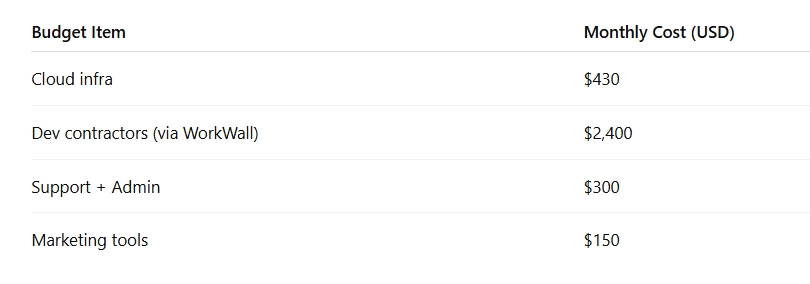.png)
.png)
In the beginning, I tried to manage everything in-house, from setting up infrastructure, pushing code, handling QA and even responding to customer emails. I thought doing it all by myself would cost less, but it only burned time and was more expensive. I had to move faster, but also didn’t want to compromise product quality. That’s when I started rethinking how I built, not just the product, but the team and workflows around it.
.png)




One of my early wins was streamlining the infrastructure. Rather than overbuilding, I focused on lean DevOps and pay-as-you-go cloud resources.
Read next:
DevOps on a Shoestring: Tech Stack Tips for Lean Startups
Key decisions:
Results: Infrastructure remained agile, costs dropped by 28%, and his dev team could push features weekly without firefighting.
I targeted remote-first SMBs with hybrid teams struggling with productivity tracking. My ICP (ideal customer profile) was clear:
I validated demand through user interviews and early LinkedIn cold outreach.
Insight: Many such companies now source on-demand dev talent through Tech Marketplace to augment product builds while keeping team size lean.
I quickly realized I couldn’t do it all. The constant context switching was unsustainable. Here's how I recovered focus:
Read next:
5 Processes to Automate Before They Burn You Out
This shift gave me back 12+ hours per week. I reallocated that time to customer discovery and roadmap refinement.
Alex’s go-to-market approach leaned heavily on content-led growth, side projects, and founder-led sales.

Read next:
From MVP to PMF: How Smart Tech Founders Scale Without Burning Out
Through this, I booked 15 demo calls in 4 weeks and signed 4 pilot users—all before exhausting my runway.
I used this lean allocation model:

Tip: Tools like WorkWall let founders like me post exact tasks or features, matching them with vetted tech contractors. You only pay for scoped work—perfect for unpredictable startup budgets.
I didn’t just build a product—he built resilience into his company. By being ruthless with focus, leveraging automation, and outsourcing smartly, I hit PMF and still slept 7 hours a night.
Key Takeaways:
Join other tech founders using WorkWall to post requirements, find vetted tech talent, and keep building—without burning out.
.png)





Technical firms must evaluate the business strategy to set a collaboration contract with other non-competing technology firms for mutual…

While starting a tech firm, scaling it into something bigger is a ball game to put your foot on. Just like a coin has two sides the business to has its sides. …

While starting a tech firm, scaling it into something bigger is a ball game to put your foot on. Just like a coin has two sides...

Outsourcing is one of the most talked about business strategies every IT firm is looking upon. The rapid pace of digital transformation has…

What is Collaboration? — “Coming together is a beginning, staying together is progress, and working together is a success.” — Henry Ford…..

To collaborate is to connect. To connect is to communicate. In a way collaboration in the IT sector connects to other firms, communicates…

Networking is the process of establishing a mutually beneficial relationship with other potential tech firms. Its benefits are the.....

To Hire or Not to Hire? Freelancers for Tech Businesses Be it its availability, or usability freelancers have seen a new curve of growth globally.....

Networking has massive benefits found in every industry and organization. From achieving the objectives to building business….
Stay ahead of the tech curve! Subscribe to our weekly newsletter for a curated dose of the latest industry insights, project highlights, and exclusive updates.